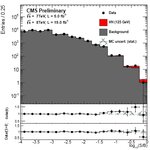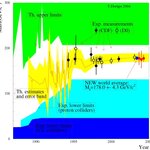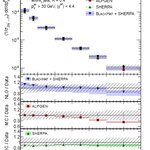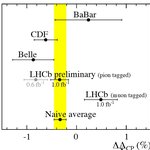Physics

"New Physics can appear at any moment but it is now conceivable that no new physics will show up at the LHC"
Guido Altarelli, LHC Nobel Symposium, May 15th 2013
It is funny reading the above quote if you are one who "conceived" that the LHC could find no new physics 7 years ago, as demonstrated by where I put my money...

Hofstadter's Butterfly, a complex pattern of the energy states of electrons that resembles a butterfly, has appeared in physics textbooks as a theoretical concept of quantum mechanics for nearly 40 years but had never been directly observed - until now.
Douglas Hofstadter, a physicist and Pulitzer Prize-winning author, first predicted the existence of the butterfly in 1976, when he imagined what would happen to electrons subjected to two forces simultaneously: a magnetic field and the periodic electric field.
The energy spectrum, or pattern of energy levels, that these dueling forces…

Finally the decay of Higgs bosons to b-quark pairs is emerging from LHC data, too.
That decay mode is the highest-probability one - about four out of five Higgs bosons will prefer to yield b-quarks when they disintegrate - but its observation is complicated by the fact that backgrounds are very large: pairs of b-quark jets are very, very common in high-energy proton-proton collisions. However, CMS has just produced results of a search which reaches enough sensitivity to that final state to allow us to be quite confident that the H->bb decay mode is there, at the expected rate.
As you will…

Supersymmetry, the extension of the Standard Model of particle physics that was once sold as an almost certain discovery that the LHC experiments would bump into upon starting to collect proton-proton collisions, is not in a very healthy situation these days.
With the null results of dozens of dedicated searches the ATLAS and CMS experiments have by now eaten out roughly half of the "reasonable" portion of the unbounded, hundred-something-dimensional parameter space of SUSY theories. And maybe what is most depressing for SUSY aficionados is that in particular the most natural values for the…

In 1992 the top quark had not been discovered yet, and it did not make much sense for the CDF collaboration to have a full meeting devoted solely to it; rather, analyses targeting the search of the top quark were presented at a meeting which dealt with both bottom and top quarks. This was called back then "Heavy Flavour meeting".
The Heavy Flavour meeting was held every second Thursday afternoon, during busy “on-weeks”, which alternated with “off-weeks” when no physics meetings were scheduled. I was back then a summer student, and together with my buddy Esov I had been instructed by our…

While school-age models of atomic nuclei show them as being spherical, like a basketball, they are more like the shape of a football.
Yet for some particular combinations of protons and neutrons, nuclei can also assume very asymmetric shapes, like a pear, where there is more mass at one end of the nucleus than the other.
The experimental observation of nuclear pear shapes by University of Liverpool researchers is important for understanding the theory of nuclear structure and for helping with experimental searches for electric dipole moments (EDM) in atoms. The Standard…

With the Higgs boson in the bag, the game called "global fit" that particle physicists have been playing for a couple of decades has changed significantly. The knowledge of the Higgs boson mass provided by the measurements obtained by the ATLAS and CMS experiments, added to dozens of other measurements of critical observable properties of subatomic particles that have been measured at LEP/SLC, LEPII, the Tevatron, and the LHC itself, allow us to constrain some of the fundamental parameters of the Standard Model more than direct experimental determinations do.
But what the heck is a…

"A detailed study of four-jet hadronic events at LEP 1.5 has been reported by the ALEPH collaboration. From selected four-jet events, the invariant masses of jet pairs are computed, and out of the three jet combinations, the one with the lowest difference in jet-pair masses is retained. [...] Not only is the total number of four-jet events observed by ALEPH at 130-140 GeV larger than expected from QCD, but this excess is contained in a narrow window around 105 GeV for the sum of jet-pair masses. In this window, about two times the width of the estimated resolution, nine events are observed…

ATLAS has just produced a very nice new study of jet production in Z-boson events. I will describe a sample graph below, but before I do I find it useful to explain to the less knowledgeable among you what a hadronic jet is, just in case you've been away during the last forty years.
Hadronic Jets: what are they ?Jet production at hadron colliders is a complex, fascinating topic that has been at the center of the stage in high-energy physics for forty years now, and does not seem to be retiring any time soon. A jet is a collimated stream of particles --light hadrons such as pions and kaons,…

One of the most intriguing effects in subatomic physics is the phenomenon of violation of the discrete symmetry called "CP". It is intriguing at various levels.
First of all, CP violation is intriguing because of the depth of the concept: proof of that be that it is not at all easy to explain it to outsiders (I will make an attempt below, but I am likely to fail!).
Second, its elusive nature makes it even more mysterious and difficult to study: only a few subatomic physical systems exhibit it, and the effect is visible only as a modification of measurable quantities at the level of a few…